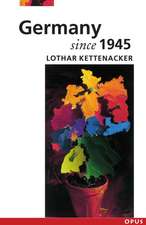The Construction of Memory in Interwar France
Autor Daniel J. Shermanen Limba Engleză Paperback – noi 2001
One of the bloodiest conflicts in human history, World War I devastated France, leaving behind battlefields littered with the remains of the dead. Daniel Sherman takes a close look at the human impact of this Great War by examining the ways in which the French remembered their veterans and war dead after the armistice. Arguing that memory is more than just a record of experience, Sherman's cultural history offers a radically new perspective on how commemoration of WWI helped to shape postwar French society and politics.
Sherman shows how a wartime visual culture saturated with images of ordinary foot soldiers, together with contemporary novels, memoirs, and tourist literature, promoted a distinctive notion of combat experience. The contrast between battlefield and home front, soldier and civilian was the basis for memory and collective gratitude. Postwar commemoration, however, also grew directly out of the long and agonized search for the remains of hundreds of thousands of missing soldiers, and the sometimes contentious debates over where to bury them. For this reason, the local monument, with its inscribed list of names and its functional resemblance to tombstones, emerged as the focal point of commemorative practice. Sherman traces every step in the process of monument building as he analyzes commemoration's competing goals—to pay tribute to the dead, to console the bereaved, and to incorporate mourners' individual memories into a larger political discourse.
Extensively illustrated, Sherman's study offers a visual record of a remarkable moment in the history of public art. It is at once a moving account of a culture haunted by war and a sophisticated analysis of the political stakes of memory in the twentieth century.
Winner of the 2000 J. Russell Major Prize of the American Historical Association
Sherman shows how a wartime visual culture saturated with images of ordinary foot soldiers, together with contemporary novels, memoirs, and tourist literature, promoted a distinctive notion of combat experience. The contrast between battlefield and home front, soldier and civilian was the basis for memory and collective gratitude. Postwar commemoration, however, also grew directly out of the long and agonized search for the remains of hundreds of thousands of missing soldiers, and the sometimes contentious debates over where to bury them. For this reason, the local monument, with its inscribed list of names and its functional resemblance to tombstones, emerged as the focal point of commemorative practice. Sherman traces every step in the process of monument building as he analyzes commemoration's competing goals—to pay tribute to the dead, to console the bereaved, and to incorporate mourners' individual memories into a larger political discourse.
Extensively illustrated, Sherman's study offers a visual record of a remarkable moment in the history of public art. It is at once a moving account of a culture haunted by war and a sophisticated analysis of the political stakes of memory in the twentieth century.
Winner of the 2000 J. Russell Major Prize of the American Historical Association
Preț: 449.82 lei
Nou
Puncte Express: 675
Preț estimativ în valută:
86.08€ • 88.93$ • 71.64£
86.08€ • 88.93$ • 71.64£
Carte tipărită la comandă
Livrare economică 25 martie-08 aprilie
Preluare comenzi: 021 569.72.76
Specificații
ISBN-13: 9780226752860
ISBN-10: 0226752860
Pagini: 448
Ilustrații: 107 halftones
Dimensiuni: 178 x 254 x 28 mm
Greutate: 0.74 kg
Ediția:1
Editura: University of Chicago Press
Colecția University of Chicago Press
ISBN-10: 0226752860
Pagini: 448
Ilustrații: 107 halftones
Dimensiuni: 178 x 254 x 28 mm
Greutate: 0.74 kg
Ediția:1
Editura: University of Chicago Press
Colecția University of Chicago Press
Cuprins
Abbreviations
List of Illustrations
Acknowledgments
Introduction: The Emergence of Commemoration
1. Experience and Memory
Narrating War
Seeing Memory
Lasting Impressions
2. Bodies and Names
An Immense Necropolis
Inscribing Absence
"This Precious Patrimony"
3. Making a Sacrifice
Structures
Resources
The Broken Plaque
4. Seeing the Signified
"A Kind of Anguished Terror": Salons, Critics and Artists
"An Artistic Character": Prefectoral Review Boards and Provincial Standards
"All My Designs Are Approved": The Business of Commemoration
"So Superior to Panegyrics": Monuments and Meanings
5. Contested Spaces
Sites of Commemoration
For God and Country?
Making It Local
Requiems for an Elm Tree
6. Dedication
Patterns of Ceremony
The Dead and the Living
The Power of Memory
Epilogue
The Thirties: Dying of the Light
The Sixties: Memory into History?
The Nineties: Return of the Repressed
Notes
Index
List of Illustrations
Acknowledgments
Introduction: The Emergence of Commemoration
1. Experience and Memory
Narrating War
Seeing Memory
Lasting Impressions
2. Bodies and Names
An Immense Necropolis
Inscribing Absence
"This Precious Patrimony"
3. Making a Sacrifice
Structures
Resources
The Broken Plaque
4. Seeing the Signified
"A Kind of Anguished Terror": Salons, Critics and Artists
"An Artistic Character": Prefectoral Review Boards and Provincial Standards
"All My Designs Are Approved": The Business of Commemoration
"So Superior to Panegyrics": Monuments and Meanings
5. Contested Spaces
Sites of Commemoration
For God and Country?
Making It Local
Requiems for an Elm Tree
6. Dedication
Patterns of Ceremony
The Dead and the Living
The Power of Memory
Epilogue
The Thirties: Dying of the Light
The Sixties: Memory into History?
The Nineties: Return of the Repressed
Notes
Index















